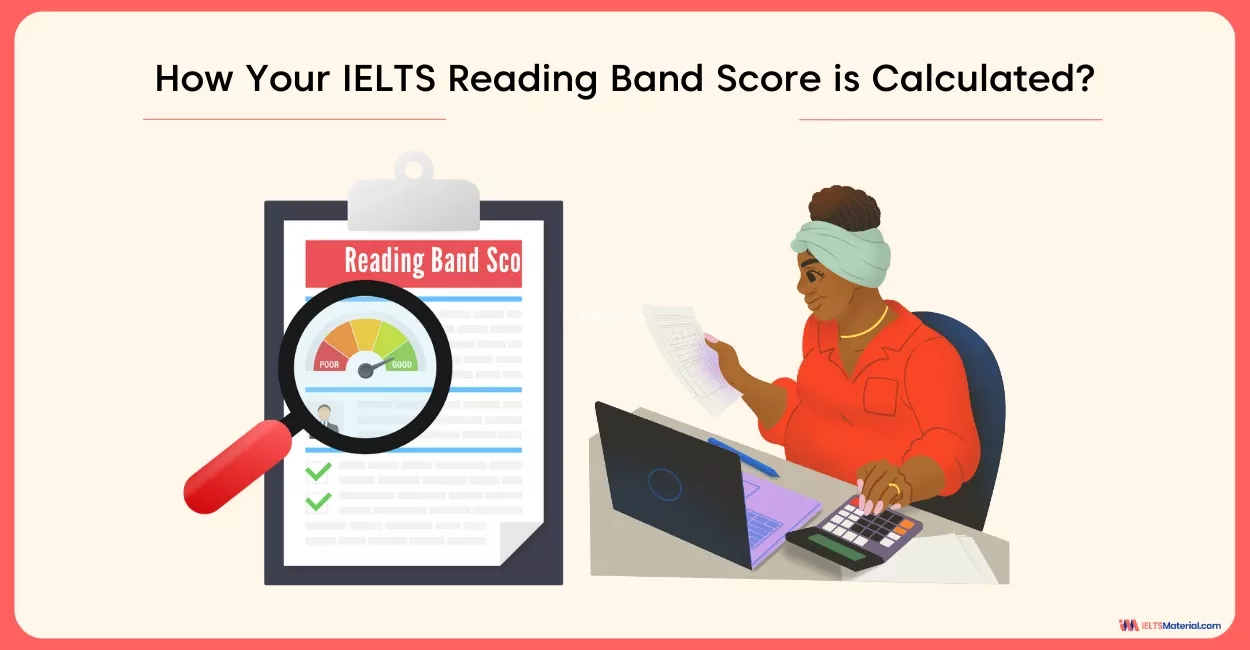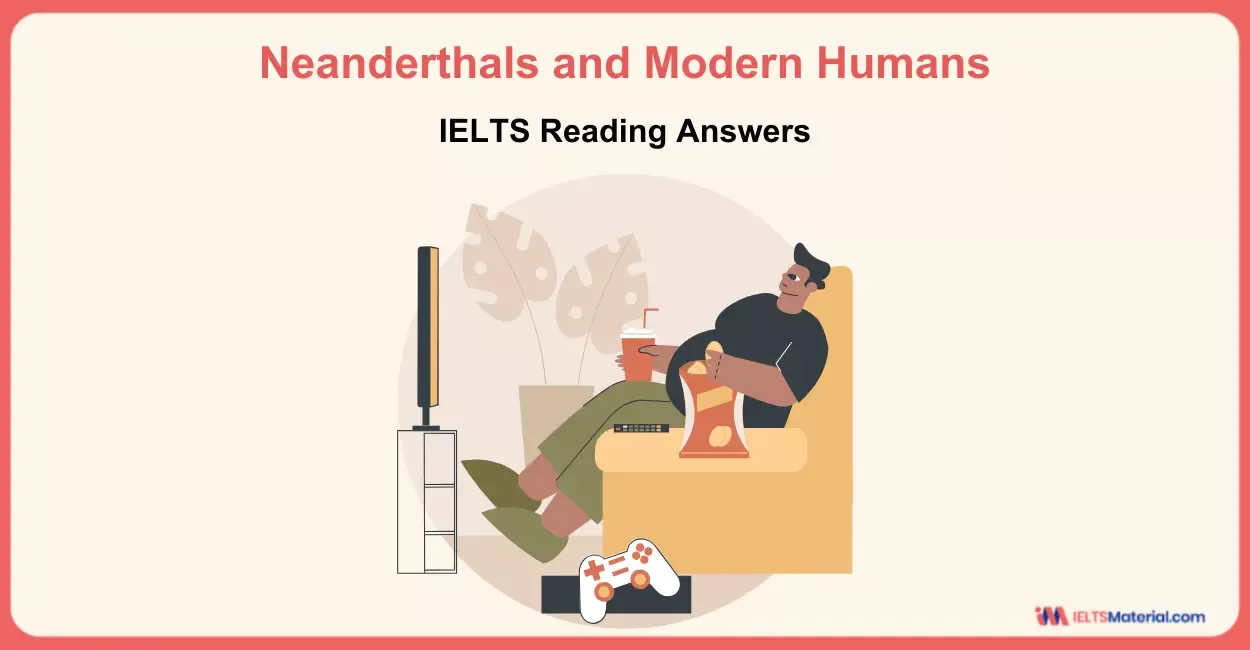Neanderthals and Modern Humans - IELTS Reading Answers
9 min read
Updated On
-
Copy link
Want to practice Matching types of questions in the IELTS Reading Section? Explore tips on how to use the passage ‘Neanderthals and Modern Humans’ to your advantage and analyze the answer to work on the areas of improvement.
Table of Contents

Limited-Time Offer : Access a FREE 10-Day IELTS Study Plan!
The Academic passage ‘Neanderthals and Modern Humans’ is a reading passage that appeared in an IELTS Test. To achieve a band 8+ in the IELTS Reading, you must learn how to break the task into manageable steps: understanding common question types, practicing keyword scanning, and becoming accustomed to skimming the passage for a big picture before concentrating on details. Following these steps will also help you improve at managing your time wisely, an area where most students struggle.
Let’s see how easy this passage is for you and if you’re able to make it in 20 minutes.
Connect with our band 9 IELTS Trainers to crack your IELTS Reading in no time! Book a FREE Demo.
Types of Questions in IELTS Reading Passage ‘Neanderthals and Modern Humans’
Before you move ahead and attempt the passage ‘Neanderthals and Modern Humans’, it is essential that you first become familiar with the questions that you will encounter. This will prepare you with strategies to approach each question confidently. With this, you can familiarize yourself with what you are good at and become aware of areas that you should be working on. The following are the questions which you need to answer in this passage.
- IELTS Reading Matching Features [Q.14 - Q.18]
- IELTS Reading Matching Information [Q.19 - Q.23]
- IELTS Reading Summary Completion[Q.24 - Q.26]
How to Use the Reading Passage 'Neanderthals and Modern Humans’ to Practice?
Attempting this passage on ‘Neanderthals and Modern Humans’ is not just about answering questions, but it is about providing a systematic approach for the IELTS Academic Reading Section. Such passages would help you to practice skimming, scanning, pinpointing the key concepts, and answering the question types. The table below depicts the stepwise strategies which will help you build confidence and find answers easily.
|
Step |
Description |
|
1. Skimming |
|
|
2. Identify Keywords |
|
|
3. Understand the Question Type |
|
|
4. Practice Scanning |
|
|
5. Confirm your answer |
|
|
6. Look at the answers given for the passage |
|
Curious to learn how to improve your reading skills to get a band 9? Check out the video below!
IELTS Reading Passage on ‘Neanderthals and Modern Humans’
You should spend about 20 minutes on Questions 1-13, which are based on the Reading Passage below.
Neanderthals and Modern Humans
A The evolutionary processes that have made modern humans so different from other animals are hard to determine without the ability to examine human species that have not achieved similar things. However, in a scientific masterpiece, Svante Paabo and his colleagues from the Max Planck Institute for Evolutionary Anthropology, in Leipzig, have made such a comparison possible. In 2009, at a meeting of the American Association for the Advancement of Science, they made public an analysis of the genome [1] of Neanderthal man.
B Homo neanderthalensis, to give its proper name, lived in Europe and parts of Asia from 400,000 years ago to 30,000 years ago. Towards the end of this period, it shared its range with interlopers in the form of Homo sapiens [2], who were spreading out from Africa. However, the two species did not settle down to a stable cohabitation. For reasons which are as yet unknown, the arrival of Homo sapiens in a region was always quickly followed by the disappearance of Neanderthals.
C Before 2009, Dr Paabo and his team had conducted only a superficial comparison between the DNA of Neanderthals and modern humans. Since then, they have performed a more thorough study and, in doing so, have shed a fascinating light on the intertwined history of the two species. That history turns out to be more intertwined than many had previously believed.
D Dr Paabo and his colleagues compared their Neanderthal genome (painstakingly reconstructed from three bone samples collected from a cave in Croatia) with that of five living humans from various parts of Africa and Eurasia. Previous genetic analysis, which had only examined DNA passed from mother to child in cellular structures called mitochondria, had suggested no interbreeding between Neanderthals and modern humans. The new, more extensive examination, which looks at DNA in the cell nucleus rather than in the mitochondria, shows this conclusion is wrong. By comparing the DNA in the cell nucleus of Africans (whose ancestors could not have crossbred with Neanderthals, since they did not overlap with them) and various Eurasians (whose ancestors could have crossbred with Neanderthals), Dr Paabo has shown that Eurasians are between one percent and four percent Neanderthal.
E That is intriguing. It shows that even after several hundred thousand years of separation, the two species were inter-fertile. It is strange, though, that no Neanderthal mitochondrial DNA has turned up in modern humans, since the usual pattern of invasion in historical times was for the invaders’ males to mate with the invaded’s females. One piece of self-knowledge, then - at least for non-Africans - is that they have a dash of Neanderthal in them. But Dr Paabo’s work also illuminates the differences between the species. By comparing modem humans, Neanderthals, and chimpanzees, it is possible to distinguish genetic changes which are shared by several species of humans in their evolution away from the great-ape lineage, from those which are unique to Homo sapiens.
F More than 90 percent of the ‘human accelerated regions’ [3] that have been identified in modem people are found in Neanderthals too. However, the rest are not. Dr Paabo has identified 212 parts of the genome that seem to have undergone significant evolution since the species split. The state of genome science is still quite primitive, and it is often unclear what any given bit of DNA is actually doing. But an examination of the 20 largest regions of DNA that have evolved in this way shows that they include several genes which are associated with cognitive ability, and whose malfunction causes serious mental problems. These genes, therefore, look like good places to start the search for modern humanity’s essence.
G The newly evolved regions of DNA also include a gene called RUNX2, which controls bone growth. That may account for differences in the shape of the skull and the rib cage between the two species. By contrast, an earlier phase of the study had already shown that Neanderthals and moderns share the same version of a gene called FOXP2, which is involved in the ability to speak, and which differs in chimpanzees. It is all, then, very promising - and a second coup in quick succession for Dr Paabo. Another of his teams has revealed the existence of a hitherto unsuspected species of human, using mitochondrial DNA found in a little-finger bone. If that species, too, could have its full genome read, humanity’s ability to know itself would be enhanced even further.
[1] an individual’s complete set of genes
[2] the scientific name for modem humans
[3] parts of the human brain which evolved very rapidly
Questions 14-18
Look at the following characteristics (Questions 14-18) and the list of species below.
Match each feature with the correct species, A, B or C.
Write the correct letter, A, B or C in boxes 14-18 on your answer sheet.
NB. You may use any letter more than once.
14. Once lived in Europe and Asia.
15. Originated in Africa.
16. Did not survive long after the arrival of immigrants.
17. Interbred with another species.
18. Appears not to have passed on mitochondrial DNA to another species.
|
List of Species
|
Questions 19-23
The Reading Passage has seven paragraphs, A-G.
Which paragraph contains the following information?
Write the correct letter, A-G, in boxes 19-23 on your answer sheet.
19. an account of the rejection of a theory
20. reference to an unexplained link between two events
21. the identification of a skill-related gene common to both Neanderthals and modern humans
22. the announcement of a scientific breakthrough
23. an interesting gap in existing knowledge
Questions 24-26
Complete the summary below.
Choose NO MORE THAN THREE WORDS from the passage for each answer.
The nature of modern humans
Recent work in the field of evolutionary anthropology has made it possible to compare modern humans with other related species. Genetic analysis resulted in several new findings. First, despite the length of time for which Homo sapiens and Homo neanderthalensis had developed separately, 24 _____________________ did take place. Secondly, genes which evolved after modern humans split from Neanderthals are connected with cognitive ability and skeletal 25 _____________________ . The potential for this line of research to shed light on the nature of modern humans was further strengthened when analysis of a 26 _____________________ led to the discovery of a new human species.
Grab the IELTS Reading (Academic) Test Guide: Essential Tips, Strategies, and Practice Tests” (April-June 2025) today!
Answers with Location and Explanation on IELTS Passage ‘Neanderthals and Modern Humans’
Review the answers provided for the reading passage ‘Neanderthals and Modern Humans’, along with their locations and explanations. Once you see the pattern in your mistakes, you can adjust your approach to make these skills stronger. Such a reflection will improve your reading skills and increase your chances of attaining a higher IELTS Band Score.
Unlock Answers
|
Question Number |
Answer |
Explanation |
Location |
|
1 |
C |
Homo neanderthalensis, lived, Europe, Asia, 400,000 years ago, 30,000 years ago, end of this period, shared, with, Homo sapiens |
Para B, first 3 lines |
|
2 |
B |
who were spreading out from Africa |
Para B, line 3 |
|
3 |
A |
arrival, Homo sapiens, quickly followed by the disappearance of Neanderthals |
Para B, last 2 lines |
|
4 |
C |
the two species were inter-fertile |
Para E, first 2 lines |
|
5 |
A |
no Neanderthal mitochondrial DNA, turned up in modern humans |
Para E, lines 2-3 |
|
6 |
D |
new, more extensive examination, shows this conclusion is wrong |
Para D, lines 5-7 |
|
7 |
B |
For reasons which are as yet unknown |
Para B, line 4 |
|
8 |
G |
Neanderthals and moderns share, same version, gene, FOXP2, involved, ability to speak |
Para G, lines 3-5 |
|
9 |
A |
However, Svante Paabo, Max Planck Institute, made, comparison possible |
Para A, lines 3-5 |
|
10 |
E |
strange, no Neanderthal mitochondrial DNA, in modern humans, usual pattern of invasion invaders’ males, mate with the invaded’s females |
Para E, lines 2-4 |
|
11 |
interbreeding |
two species were inter-fertile |
Para E, line 2 |
|
12 |
growth |
gene, RUNX2, controls bone growth |
Para G, first 2 lines |
|
13 |
Little-finger bone |
using mitochondrial DNA, little-finger bone |
Para G, line 6 |
Enroll into our Free IELTS Webinar and learn more about techniques to improve your reading speed.
Continue practicing more reading passages like this one on ‘Neanderthals and Modern Humans’ so that you can use the strategies. With each passage that you attempt, you become better at finding keywords, understanding the context, and getting familiar with different question types. Therefore, focus on strategies, understanding specific patterns, and simulating exam conditions for developing time management skills.
Check More IELTS Reading Answers
Also Check:
Practice IELTS Reading based on question types

Start Preparing for IELTS: Get Your 10-Day Study Plan Today!
Explore other Reading Practice Tests

Kasturika Samanta

Kasturika Samanta

Nehasri Ravishenbagam
Recent Articles

Nehasri Ravishenbagam

Haniya Yashfeen

Haniya Yashfeen

Haniya Yashfeen





Post your Comments